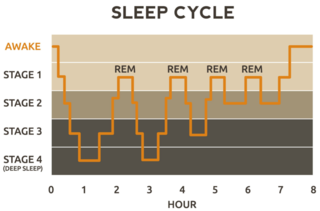Rapid Eye Movement Sleep May Have Life-Preserving Benefits
Less REM sleep is associated with increased mortality risk, a new study finds.
Posted Jul 08, 2020
THE BASICS

REM is the sleep cycle stage when dreaming occurs. Rapid eye movement “dream sleep” occurs cyclically about every 90 minutes in between the other “dreamless” stages of non-REM (NREM) sleep.Source: Becris/Shutterstock
A new Stanford-led study reports that middle-aged and older adults who experience less rapid eye movement (REM) sleep tend to have a higher risk of all-cause mortality. The research question for this study was straightforward: “Is less REM sleep associated with increased mortality?” And the answer appears to be “yes.” These findings suggest that REM may be the most crucial sleep stage when it comes to survival.
The study (Leary et al., 2020) was published on July 6 in the journal JAMA Neurology. The researchers found that for every 5% reduction in REM sleep among a cohort of 2,675 older men who were followed for over a decade, there was a 13% to 17% uptick in mortality rates. These results were replicated in another cohort of study participants that consisted of 1,375 middle-aged men and women who were followed for over two decades.
“Numerous studies have linked insufficient sleep with significant health consequences. Yet many people ignore the signs of sleep problems or don’t allow enough time to get adequate sleep,” first author Eileen Leary of Stanford University said in a news release. “In our busy, fast-paced lives, sleep can feel like a time-consuming nuisance. This study found in two independent cohorts that lower levels of REM sleep was associated with higher rates of mortality.”
In recent weeks, other human and animal studies have also put REM sleep in the spotlight. For example, last month, a study (Drews et al., 2020) led by researchers in Germany reported that human couples who sleep in the same bed tend to show an increase in REM sleep compared to when each person was observed while sleeping alone in a single bed. This study, “Bed-Sharing in Couples Is Associated With Increased and Stabilized REM Sleep and Sleep-Stage Synchronization,” was published on June 24 in the journal Frontiers in Psychiatry.
This research on the link between couples’ sharing a bed and REM sleep was conducted by an international team led by Henning Johannes Drews of Germany’s Center for Integrative Psychiatry. “As compared to sleeping individually, co-sleeping was associated with about 10% more REM sleep, less fragmented REM sleep, longer undisturbed REM fragments,” the authors concluded.
Another recent REM sleep study (Kumar et al., 2020) in mice by researchers from the University of Tsukuba and the University of Tokyo in Japan found that increased activity of adult-born neurons in the hippocampus during rapid eye movement sleep helps the brain consolidate memories. These findings were published on June 4 in the journal Neuron.
A July 6 JAMA Neurology editorial, “Should Neurologists Be Concerned About REM Sleep Quantity?” co-authored by Michael Jaffe of the University of Florida’s department of neurology chronicles the growing body of evidence linking rapid eye movement sleep with psychological and physical well-being, and now, longevity.article continues after advertisement
“This study [Leary et al., 2020] shows yet another reason for the importance of proper sleep time—recommendations for adults is seven hours—and a good balance of sleep stages by assuring that any possible conditions, such as obstructive sleep apnea, that can cause a reduction in REM [should] be evaluated and managed,” Jaffe stated in the news release. “Anyone with difficulty sleeping or with loud snoring can benefit from discussing this with their physician.”
“REM sleep appears to be a reliable predictor of mortality and may have other predictive health values,” Leary concluded. “Strategies to preserve REM may influence clinical therapies and reduce mortality risk, particularly for adults with less than 15% of REM sleep.”
References
Eileen B. Leary, Kathleen T. Watson, Sonia Ancoli-Israel, Susan Redline, Kristine Yaffe, Laurel A. Ravelo, Paul E. Peppard, James Zou, Steven N. Goodman, Emmanuel Mignot, Katie L. Stone. “Association of Rapid Eye Movement Sleep With Mortality in Middle-aged and Older Adults” JAMA Neurology (First published online: July 06, 2020) DOI: 10.1001/jamaneurol.2020.2108
Michael S. Jaffee, Liza H. Ashbrook, Milena K. Pavlova. “Should Neurologists Be Concerned With REM Sleep Quantity?” Editorial in JAMA Neurology (First published online: July 06, 2020) DOI: 10.1001/jamaneurol.2020.2122
Henning Johannes Drews, Sebastian Wallot, Philip Brysch, Hannah Berger-Johannsen, Sara Lena Weinhold, Panagiotis Mitkidis, Paul Christian Baier, Julia Lechinger, Andreas Roepstorff. and Robert Göder. “Bed-Sharing in Couples Is Associated With Increased and Stabilized REM Sleep and Sleep-Stage Synchronization.” Frontiers in Psychiatry (First published: June 25, 2020) DOI: 10.3389/fpsyt.2020.00583
Deependra Kumar et al. “Sparse Activity of Hippocampal Adult-Born Neurons During REM Sleep Is Necessary for Memory Consolidation.” Neuron (First published online: June 04, 2020) DOI: 10.1016/j.neuron.2020.05.008